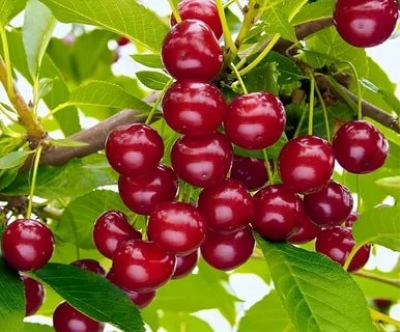
- Authors: A.I. Bolotov, N.I. Gvozdyukova, M.G. Isakova (Sverdlovsk Horticultural Selection Station)
- Barrel type: bush
- Growth type: undersized
- Crown: wide, spreading, medium density
- Foliage: medium
- Leaves: elongated oval, green, no anthocyanin coloration
- Flowers: saucer
- Flowering and fruiting type: mixed - on bouquet branches and annual growth
- Fruit size, mm: height 14.6, width 15.5, thickness 14.5
- Fruit shape: wide round
The Bolotovskaya steppe cherry variety is most often used in the preparation of jam, compotes, homemade jams. It has a high yield, resistance to various diseases, temperature changes.
Description of the variety
This species grows in the form of a weakly growing bush, the height of which is on average 1.6-1.8 m. The crown of such vegetation is wide-rounded, spreading, of medium thickening. The leafiness of this cherry is medium.
The leaf plates have an elongated oval shape, they have a rich green color. Their surface has a glossy sheen. The edges of the foliage are slightly wavy. Its tip is pointed.
The flowers have a special saucer shape. Each inflorescence contains 4 small flowers. The type of flowering and fruiting in the species is mixed. The age of such bushes is more than 30 years. The buds on the bushes grow oval. In relation to the shoots, they are spaced.
Fruit characteristics
Small berries of this variety have a mass of 3-4 grams. Their shape is wide-angle. Ripe fruits are dark red in color. Their pulp is quite juicy, of medium density.
The weight of the bone inside is on average only 0.17 grams. The separation of the bone from the pulp is good. The separation of the fruits is dry. Ripe berries are resistant to cracking. Fruiting in this variety is annual.
Taste qualities
The taste of such cherries is sweet and sour, satisfactory. In their raw form, berries are practically not eaten, but at the same time they are perfect for preparing various sweet dishes.
Ripening and fruiting
Bolotovskaya cherry begins to bear fruit in the third year after planting. Flowering period May 25 - July 2. This species is considered to be medium late. The fruiting period occurs in the first decade of August. The nature of maturation is non-simultaneous.

Yield
Cherry Bolotovskaya has a high yield. From one hectare planted it will be possible to collect up to 70-80 centners of berries. It is due to its yield that this variety can be used for growing on an industrial scale.
Landing
The planting of such a cherry is carried out according to the scheme of 2.5x2 meters.


Growing and care
It should be remembered that this variety is steppe, hence all its features and basic requirements are derived. Planting can be carried out only when the soil warms up very well. Most often, planting dates are at the end of May - beginning of June.
Like all steppe cherries, Bolotovskaya prefers well-lit areas. It is better to select open places. Remember that these species do not like lowlands and too swampy soils.
For this steppe cherry, carbonate soils will be the best option. If you plant it on a different soil, then humus and dolomite flour are first introduced into it.
Planting holes cannot be dug in the fall, as is done for many other varieties. Wells are formed before planting. Nutrient fertilizers are necessarily introduced there.
In the first year after planting in a permanent place, such cherry seedlings will need regular abundant watering and loosening. Further, the culture must be moistened only with prolonged establishment of hot and dry weather. Do not forget to promptly remove all weeds around the bushes.


Disease and pest resistance
Bolotovskaya cherry has a fairly high resistance to pests, but low resistance to fungal diseases. It is often affected by coccomycosis, while small dots appear on the leaves, which over time grow strongly and turn into large holes. Then the foliage just starts to fall off. To cure vegetation, it is better to use preparations that contain copper. To avoid the appearance of such a disease, you need to remove all fallen leaves in time, carry out pruning.
In addition, this cherry can be affected by moniliosis, in which the vegetative parts dry out, and then whole branches, the bark over time is covered with cracks of various sizes. Copper preparations can also be used to combat moniliosis.
Sometimes on Bolotovskaya cherry you can see cherry aphids, they live on leaf plates and shoots, suck juices from vegetation. For minor lesions, a solution with laundry soap is used. For severe damage, it is better to use insecticides.
































































